HP dm1z: Taking Fusion on the Road
by Dustin Sklavos on February 21, 2011 7:00 PM ESTBattery Life
The big news with Brazos, and by extension the HP dm1z, is the substantially improved battery life over Nile. While performance is nowhere near a strict win over that platform (Atom on the other hand...), power efficiency absolutely is. Take a look at this.
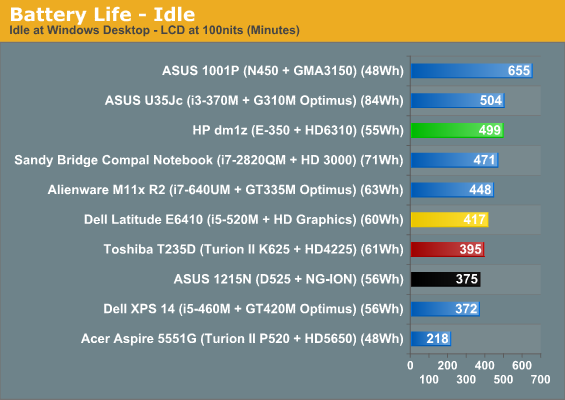
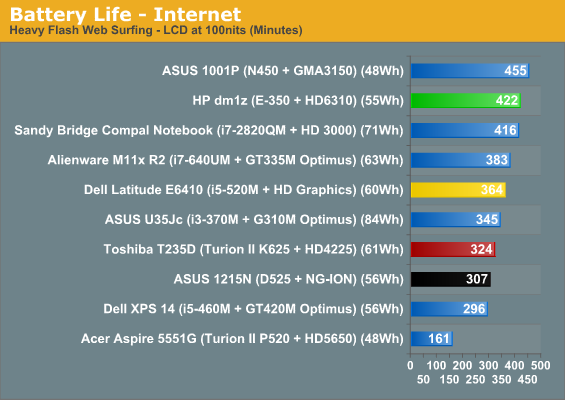
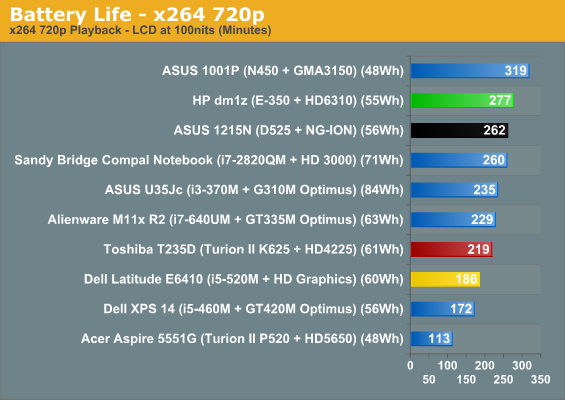
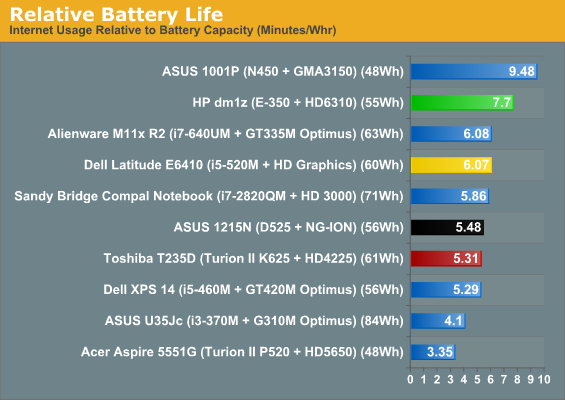
While portable gamers are probably still going to want to hang with Alienware's M11x, Brazos basically tells Intel's dual-core Atom to pound sand. The dm1z doesn't hit the battery life HP advertises (9.5 hours is pretty optimistic, probably only possible with wireless and Bluetooth disabled and the screen at the lowest brightness), but it still pulls more than seven hours of useful running time with a reasonable screen brightness and runs roughshod over Nile.
Heat and Noise
Unfortunately, where things get a little dicey (at least with the HP dm1z) is noise. First, the good news: heat output.

The internal components run at fairly reasonable temperatures, if a little on the high side, but fortunately those temperatures don't translate into an uncomfortable user experience. Quite the opposite in fact: the dm1z can happily be used on your lap without scalding you.

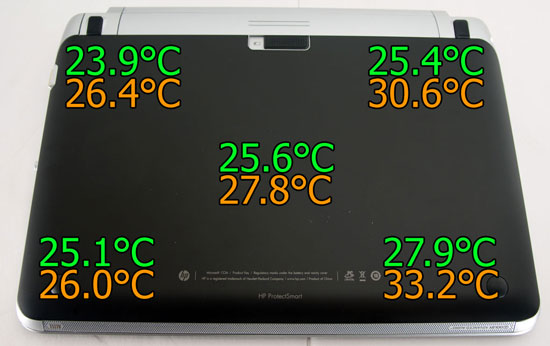
At idle the HP dm1z remains nice and frosty, and under sustained load the outside temperatures don't increase enough to make using the dm1z uncomfortable. But remember what I said about noise?
Part of the reason the dm1z is able to stay so comfortable is because the fan is almost constantly running. It's fairly low and not too obtrusive, but I have an AMD-based 15.6" Sony notebook on hand for review that runs quieter than the dm1z does at both idle and load. That may not be entirely fair because the 15.6" machine has more breathing room in the larger chassis, but it's nonetheless an issue. The fan in the dm1z doesn't spin up that much under heavy load, which would be more appreciated if HP was able to tune it to run just a little quieter at idle. This isn't make-or-break noise, but it's worth bringing up.
Update: Several of our readers pointed out that the HP dm1z has a utility called CoolSense as part of the HP Support Tools. It's supposed to allow some customization fan speeds to allow users to configure their laptop to prefer lower temperatures/higher noise, or lower noise/higher temperatures. As a matter of course we disable most of the manufacturer utilities to allow for optimal battery life results, so the above remarks reflect using the laptop without CoolSense enabled. Unfortunately, the dm1z has already been returned, so we are unable to run updated results. Anecdotally, noise is much better with CoolSense enabled.










108 Comments
View All Comments
motomen2 - Tuesday, February 22, 2011 - link
I am also hoping for a review of the Thinkpad x120e! I am a previos owner of a Thinkpad and if it stacks up well against this one, I plan to buy it.Any news on this front?
JumpingJack - Monday, February 21, 2011 - link
I thought netbooks were considered to be screen sizes 10 inches or less, this is a bit large to be a 'netbook'.strikeback03 - Tuesday, February 22, 2011 - link
"Netbook" seems to be as much in relation to performance as size. There are 12 inch units that can't be considered anything but netbooks given that they use the same internals, just a little larger. So basically if you are looking at an 11.6" screen and Atom, it is a netbook. If it is an 11.6" screen and a C2D, not a netbook.mgl888 - Monday, February 21, 2011 - link
Thanks! Been waiting for this one to get reviewed!Can't wait for mine to arrive. I can tuck away my N270 Atom. w00t!
AmdInside - Monday, February 21, 2011 - link
At this point in time, I would only be interested in this netbook if I was a college student and couldn't afford a notebook or if I was just too poor to afford a notebook but needed a portable PC for some reason. The netbook craze has died since the iPad. I tried to like netbooks last year but either they were too expensive (and thus approaching notebook pricing) or just too limited. The iPad fill the void I had with a netbook. I just have no desire for this or any other netbook.mgl888 - Tuesday, February 22, 2011 - link
It really depends on what you use the device for.For me, an ultraportable (not an iPad) like this fills the gap between my desktop and my smartphone. There's no point for me to get a tablet because an Android tablet/iPad would simply be a repeat of everything I can already do with my phone on the go.
I would not choose a 14"+ notebook because it's just too bulky to carry around and the battery life is usually not as great. I've tried Atoms, but yes they are too slow for my taste. Fusion, on the other hand, fits my taste almost perfectly.
It would be nice to have better CPU performance and perhaps a slightly larger screen, but this is as close as it gets right now. Perhaps Llano will strike on target?
DanNeely - Monday, February 21, 2011 - link
The first half of the pricing link "Starting at $4" goes to cyberpowerpc, not hp.JarredWalton - Tuesday, February 22, 2011 - link
Thanks, fixed... and the HP shopping link works properly as well now.Aone - Monday, February 21, 2011 - link
I would appreciate if the auther have used the proper terms.Netbook, as it was introduced by Intel, is 10" box. HP DM1z has 11.6 screen and that is the big difference.
If AT wants to compare AMD's offering with Intel's one in proper manner i.e. in netbook space he should take C-50 but not E-350. Do it and you feel the big difference!
cyrusfox - Tuesday, February 22, 2011 - link
Markets change and so do terms, Intel didn't create the term by the way. Been around before atom or Asus. They gained the most recognition through the intriguing asus eee 700 and its successors.See wiki excerpts below:
http://en.wikipedia.org/wiki/Netbook
"The generic use of the term "netbook", however, began in 2007 when Asus unveiled the ASUS Eee PC. Originally designed for emerging markets, the 23 × 17 cm (9.1 × 6.7 in) device weighed about 0.9 kg (2 lb) and featured a 7 in (18 cm) display, a keyboard approximately 85% the size of a normal keyboard, a solid-state drive and a custom version of Linux with a simplified user interface geared towards netbook use."
"In the short period since their appearance, netbooks have grown in size and features, now converging with new smaller, lighter notebooks. By August 2009, when comparing a Dell netbook to a Dell notebook, CNET called netbooks "nothing more than smaller, cheaper notebooks," noting, "the specs are so similar that the average shopper would likely be confused as to why one is better than the other," and "the only conclusion is that there really is no distinction between the devices.""
So you can be like engadget and others and call it a notbook if you choose, everything a netbook should be(peppy/versatile with the battery life and size of a netbook).